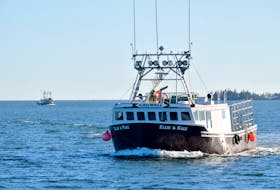FORT LAWRENCE, N.S. — If it had been finished, the Chignecto Marine Ship Railway would’ve been an engineering marvel of the early 20th century. Today, its remnants are falling into the Bay of Fundy.
Bill Casey, who ended close to three decades of political life with the Oct. 21 federal election, is now working to encourage the province to save the stones and workings that were part of the project from being lost forever because of coastal erosion.
“I'm concerned a lot of building blocks, that are owned by the provincial government, are falling into the Bay of Fundy. To me, it’s really important we retrieve the ones we’ve lost and move the ones that remain,” said Casey, while showing MP-elect Lenore Zann what was the Fort Lawrence terminus for the ship railway project. “They are cut stones and are very much a part of the ship railway. When I was a kid they were high and dry, but now because of rising sea levels and erosion they are falling into the bay.”
Sometimes called Ketchum’s Dream, the ship railway was the brainchild of civil engineer Henry Ketchum, who in 1875 proposed building a railway for ships across the Isthmus of Chignecto at its shortest point from the Bay of Fundy at Fort Lawrence to the Northumberland Strait at Tidnish – shortening a trip between the bay and the Gulf of St. Lawrence by about 930 kilometres.
The project would see a ship lifted out of the water at one end and onto a rail car for transport across the isthmus then place it back in the water at the other end using a hoist and lock system.
Ketchum submitted his proposal to the fledgling Canadian government in 1881 and construction began in 1888. It was three-quarters completed in 1890 when financial problems hit the project, causing it to grind to a halt in 1891. The federal government refused to extend its support of the project and Ketchum himself died suddenly in Amherst in 1896.
Casey’s family owned the 142-hectare, 27-kilometre long property for more than 40 years before selling it to the province in February 2012.
“We have to save this,” Casey said. “I had Lands and Forests Minister Iain Rankin out to see the rocks and appreciate them, but now is time for us to do something before it’s too late,” Casey said. “We also should do more to promote it as a historical site which reflects the innovative nature of Nova Scotians, our seagoing heritage and our engineering capacity. It is one of the very few national historic civil engineering sites in Canada. It should be part of our tourism.”
Casey said people have an interest in rail history. In August 2018, the British Broadcasting Corporation sent a film crew to Fort Lawrence to film a segment for the network’s Great American Railway Journeys that explores the impact of railways on North America and its success as a world leader in commercial activity.
Stone foundations of the machinery used for hydraulic lifts remain at the Fort Lawrence end of the 142-hectare, 27-kilometre long railway and many of the remaining barrels of concrete left from the construction are piled exactly where they were left when worked stopped in 1890.
The wood of the barrels has disintegrated and the steel hoops around them have pretty much disappeared.
“The stones have been falling into the bay for several years, but it’s getting worse in recent years and they’re further out,” Casey said. “Soon, we won’t be able to retrieve them.”
Lisa Jarrett with Lands and Forestry said there are no plans at this time to retrieve the stones.
“There are a number of factors that contribute to the maintenance of our parks and trails across the province, including budget and staff resources,” Jarrett said in an email. “At this time, the department has no plans to move the stones. However, the department continues to be open to further discussions that look at this issue, and how we can help.”
Ideally, Casey said there would be some form of tourist attraction and interpretive centre located near the site that would also include information and displays featuring the former Acadian village of Beaubassin that was burned to the ground by the Acadians in 1750 to prevent it from falling into English hands.
While the ship railway property is provincially-owned and Beaubassin federally-owned, he said the two governments should be able to work together to create an attraction to get tourists off the highway as they enter the province.









